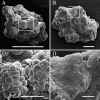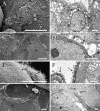Development and characterization of a three-dimensional organotypic human vaginal epithelial cell model
- PMID: 20007410
- PMCID: PMC6366157
- DOI: 10.1095/biolreprod.109.080408
Development and characterization of a three-dimensional organotypic human vaginal epithelial cell model
Abstract
We have developed an in vitro human vaginal epithelial cell (EC) model using the innovative rotating wall vessel (RWV) bioreactor technology that recapitulates in vivo structural and functional properties, including a stratified squamous epithelium with microvilli, tight junctions, microfolds, and mucus. This three-dimensional (3-D) vaginal model provides a platform for high-throughput toxicity testing of candidate microbicides targeted to combat sexually transmitted infections, effectively complementing and extending existing testing systems such as surgical explants or animal models. Vaginal ECs were grown on porous, collagen-coated microcarrier beads in a rotating, low fluid-shear environment; use of RWV bioreactor technology generated 3-D vaginal EC aggregates. Immunofluorescence and scanning and transmission electron microscopy confirmed differentiation and polarization of the 3-D EC aggregates among multiple cell layers and identified ultrastructural features important for nutrient absorption, cell-cell interactions, and pathogen defense. After treatment with a variety of toll-like receptor (TLR) agonists, cytokine production was quantified by cytometric bead array, confirming that TLRs 2, 3, 5, and 6 were expressed and functional. The 3-D vaginal aggregates were more resistant to nonoxynol-9 (N-9), a contraceptive and previous microbicide candidate, when compared to two-dimensional monolayers of the same cell line. A dose-dependent production of tumor necrosis factor-related apoptosis-inducing ligand and interleukin-1 receptor antagonist, biomarkers of cervicovaginal inflammation, correlated to microbicide toxicity in the 3-D model following N-9 treatment. These results indicate that this 3-D vaginal model could be used as a complementary tool for screening microbicide compounds for safety and efficacy, thus improving success in clinical trials.
Figures






Similar articles
-
Culturing and applications of rotating wall vessel bioreactor derived 3D epithelial cell models.J Vis Exp. 2012 Apr 3;(62):3868. doi: 10.3791/3868. J Vis Exp. 2012. PMID: 22491366 Free PMC article.
-
Human Three-Dimensional Endometrial Epithelial Cell Model To Study Host Interactions with Vaginal Bacteria and Neisseria gonorrhoeae.Infect Immun. 2017 Feb 23;85(3):e01049-16. doi: 10.1128/IAI.01049-16. Print 2017 Mar. Infect Immun. 2017. PMID: 28052997 Free PMC article.
-
The generation of 3-D tissue models based on hyaluronan hydrogel-coated microcarriers within a rotating wall vessel bioreactor.Biomaterials. 2010 Nov;31(32):8426-35. doi: 10.1016/j.biomaterials.2010.07.047. Epub 2010 Aug 7. Biomaterials. 2010. PMID: 20692703
-
Clinical development of microbicides for the prevention of HIV infection.Curr Pharm Des. 2004;10(3):315-36. doi: 10.2174/1381612043386374. Curr Pharm Des. 2004. PMID: 14754390 Review.
-
Three-Dimensional Rotating Wall Vessel-Derived Cell Culture Models for Studying Virus-Host Interactions.Viruses. 2016 Nov 9;8(11):304. doi: 10.3390/v8110304. Viruses. 2016. PMID: 27834891 Free PMC article. Review.
Cited by
-
Modeling Host-Pathogen Interactions in the Context of the Microenvironment: Three-Dimensional Cell Culture Comes of Age.Infect Immun. 2018 Oct 25;86(11):e00282-18. doi: 10.1128/IAI.00282-18. Print 2018 Nov. Infect Immun. 2018. PMID: 30181350 Free PMC article. Review.
-
Three-dimensional models of the cervicovaginal epithelia to study host-microbiome interactions and sexually transmitted infections.Pathog Dis. 2022 Aug 27;80(1):ftac026. doi: 10.1093/femspd/ftac026. Pathog Dis. 2022. PMID: 35927516 Free PMC article.
-
State-of-the-Art Metabolic Toxicity Screening and Pathway Evaluation.Anal Chem. 2016 May 3;88(9):4584-99. doi: 10.1021/acs.analchem.5b04772. Epub 2016 Apr 14. Anal Chem. 2016. PMID: 27043322 Free PMC article.
-
Characterization of 3D organotypic epithelial tissues reveals tonsil-specific differences in tonic interferon signaling.bioRxiv [Preprint]. 2023 Jan 20:2023.01.19.524743. doi: 10.1101/2023.01.19.524743. bioRxiv. 2023. Update in: PLoS One. 2023 Oct 4;18(10):e0292368. doi: 10.1371/journal.pone.0292368. PMID: 36711548 Free PMC article. Updated. Preprint.
-
Flourishing tumor organoids: History, emerging technology, and application.Bioeng Transl Med. 2023 Jun 7;8(5):e10559. doi: 10.1002/btm2.10559. eCollection 2023 Sep. Bioeng Transl Med. 2023. PMID: 37693042 Free PMC article. Review.
References
-
- Herbst-Kralovetz MM, Quayle AJ, Ficarra M, Greene S, Rose WA II, Chesson R, Spagnuolo RA, Pyles RB. Quantification and comparison of toll-like receptor expression and responsiveness in primary and immortalized human female lower genital tract epithelia. Am J Reprod Immunol 2008; 59:212–224. - PubMed
-
- Quayle AJ. The innate and early immune response to pathogen challenge in the female genital tract and the pivotal role of epithelial cells. J Reprod Immunol 2002; 57:61–79. - PubMed
-
- Fichorova RN, Rheinwald JG, Anderson DJ. Generation of papillomavirus-immortalized cell lines from normal human ectocervical, endocervical, and vaginal epithelium that maintains expression of tissue-specific differentiation proteins. Biol Reprod 1997; 57:847–855. - PubMed
-
- DeSouza MM, Lagow E, Carson DD. Mucin functions and expression in mammalian reproductive tract tissues. Biochem Biophys Res Comm 1998; 247:1–6. - PubMed
-
- Fedele L, Bianchi S, Berlanda N, Fontana E, Raffaelli R, Bulfoni A, Braidotti P. Neovaginal mucosa after Vecchietti's laparoscopic operation for Rokitansky syndrome: structural and ultrastructural study. Am J Obstet Gynecol 2006; 195:56–61. - PubMed
Publication types
MeSH terms
Substances
Grants and funding
LinkOut - more resources
Full Text Sources
Other Literature Sources

